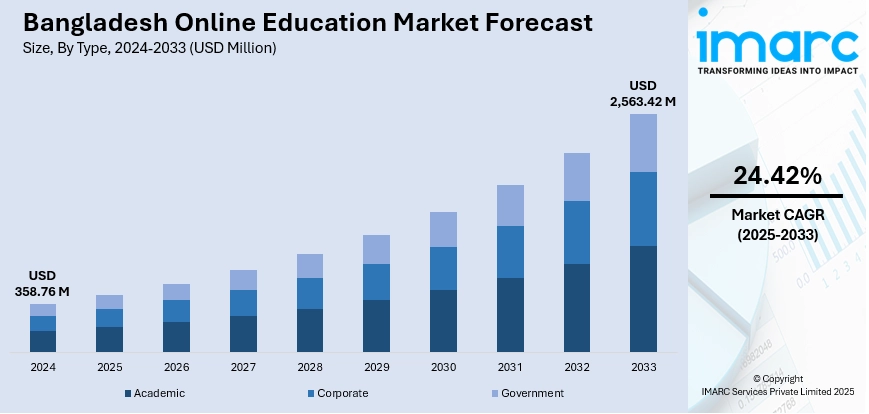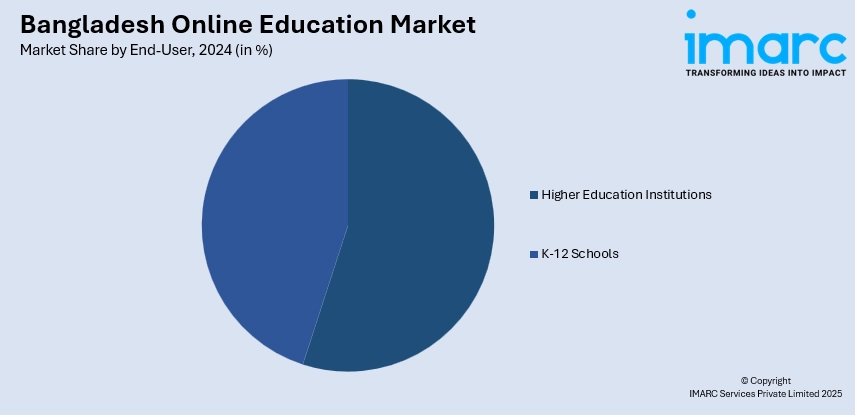
Bangladesh Online Education Market Size, Share, Trends and Forecast by Type, Provider, Technology, End-User, and Region, 2025-2033
Bangladesh Online Education Market Overview:
The Bangladesh online education market size reached USD 358.76 Million in 2024. Looking forward, the market is expected to reach USD 2,563.42 Million by 2033, exhibiting a growth rate (CAGR) of 24.42% during 2025-2033. The market is expanding rapidly as students, working professionals, and corporates turn to digital platforms for flexible, accessible learning opportunities. The COVID-era surge in platforms and edtech startups has fueled the growth of live classes, test prep, and vocational courses. Infrastructure improvements and rising tech adoption are enabling inclusivity and skill development, strengthening the Bangladesh online education market share.
|
Report Attribute
|
Key Statistics
|
|---|---|
|
Base Year
|
2024 |
|
Forecast Years
|
2025-2033
|
|
Historical Years
|
2019-2024
|
| Market Size in 2024 | USD 358.76 Million |
| Market Forecast in 2033 | USD 2,563.42 Million |
| Market Growth Rate 2025-2033 | 24.42% |
Bangladesh Online Education Market Trends:
Convenience and Accessibility
Online education in Bangladesh thrives on its ability to overcome barriers of location, traffic, and weather, offering students the freedom to learn from anywhere at any time. EdTech platforms leverage cloud infrastructure and mobile apps to deliver lessons and resources seamlessly, even in areas with limited connectivity, making digital learning practical and appealing. The convenience of aligning study schedules with personal and professional commitments resonates deeply with busy learners. Whether preparing for school exams or upskilling professionally, users value uninterrupted access to educational content. As a result, platforms have seen rapid uptake in both urban centers and rural communities. This democratization of learning empowers students and working professionals alike, establishing convenience as a foundational pillar of Bangladesh’s growing online education ecosystem.

To get more information on this market, Request Sample
Government Support and Infrastructure Improvement
Government-backed initiatives like the “Digital Bangladesh” and Smart Bangladesh visions have been instrumental in expanding access to online education. These policies prioritize ICT integration in educational institutions, fostering digital readiness. Investments in distributing tablets and laptops, setting up digital classrooms, and training educators have strengthened the foundation for EdTech adoption. Improved broadband coverage and mobile internet penetration help connect more learners across rural and urban areas. Additionally, government collaboration with NGOs and community centers to support online learning platforms amplifies reach. These coordinated efforts are enabling a more resilient and equitable education system, which is further driving the Bangladesh online education market growth. With strengthened infrastructure and official endorsement, online education is fast becoming an integral part of Bangladesh’s educational landscape.
Personalized and Skill-Oriented Learning
A surge in demand for personalized learning has catalyzed innovation in Bangladesh’s online education space. EdTech platforms are offering tailored content catering to K‑12 exam prep, vocational training, coding, language learning, and career development. Popular platforms such as 10 Minute School and Shikho provide live classes, quizzes, and analytical feedback that adapt to each student’s pace and needs. Additionally, career-focused platforms like Keeron leverage brand trust to connect learners with industry-relevant upskilling courses and employer partnerships. This shift from generic content to targeted, personalized offerings enhance learner engagement and outcomes. It also positions online education as a credible alternative for formal and informal skill development among students and professionals alike in Bangladesh.
Bangladesh Online Education Market Segmentation:
IMARC Group provides an analysis of the key trends in each segment of the market, along with forecasts at the country and regional levels for 2025-2033. Our report has categorized the market based on type, provider, technology, and end-user.
Type Insights:
- Academic
- Higher Education
- Vocational Training
- K-12 Education
- Corporate
- Large Enterprises
- SMBs
- Government
The report has provided a detailed breakup and analysis of the market based on the type. This includes academic (higher education, vocational training, K-12 education), corporate (large enterprises, SMBs), and government.
Provider Insights:
- Content
- Services
The report has provided a detailed breakup and analysis of the market based on the provider. This includes content and services.
Technology Insights:
- Mobile E-Learning
- Rapid E-Learning
- Virtual Classroom
- Others
A detailed breakup and analysis of the market based on the technology have also been provided in the report. This includes mobile e-learning, rapid e-learning, virtual classroom, and others.
End-User Insights:

- Higher Education Institutions
- K-12 Schools
A detailed breakup and analysis of the market based on the end-user have also been provided in the report. This includes higher education institutions and K-12 schools.
Regional Insights:
- Dhaka
- Chattogram
- Khulna
- Rajshahi
- Others
The report has also provided a comprehensive analysis of all the major regional markets, which include Dhaka, Chattogram, Khulna, Rajshahi, and others.
Competitive Landscape:
The market research report has also provided a comprehensive analysis of the competitive landscape. Competitive analysis such as market structure, key player positioning, top winning strategies, competitive dashboard, and company evaluation quadrant has been covered in the report. Also, detailed profiles of all major companies have been provided.
Bangladesh Online Education Market News:
- In November 2024, IWS Online School launched its state-of-the-art digital platform in Bangladesh, delivering high-quality education from Class 1 through A Levels to local students. As the first virtual school in the country to receive accreditation from Cambridge Assessment International Education (CAIE), IWS Online combines strong academic instruction with vital life skills development, ensuring a well-rounded learning experience.
- In October 2023, 10 Minute School, a prominent EdTech platform for K12 and skill development in Bangladesh, revealed that it had secured $5.5 million (Tk 61 crore) in its pre-Series A round, which was headed by Conjunction Capital, a venture capital firm.
Bangladesh Online Education Market Report Coverage:
| Report Features | Details |
|---|---|
| Base Year of the Analysis | 2024 |
| Historical Period | 2019-2024 |
| Forecast Period | 2025-2033 |
| Units | Million USD |
| Scope of the Report |
Exploration of Historical Trends and Market Outlook, Industry Catalysts and Challenges, Segment-Wise Historical and Future Market Assessment:
|
| Types Covered |
|
| Providers Covered | Content, Services |
| Technologies Covered | Mobile E-Learning, Rapid E-Learning, Virtual Classroom, Others |
| End-Users Covered | Higher Education Institutions, K-12 Schools |
| Regions Covered | Dhaka, Chattogram, Khulna, Rajshahi, Others |
| Customization Scope | 10% Free Customization |
| Post-Sale Analyst Support | 10-12 Weeks |
| Delivery Format | PDF and Excel through Email (We can also provide the editable version of the report in PPT/Word format on special request) |
Key Questions Answered in This Report:
- How has the Bangladesh online education market performed so far and how will it perform in the coming years?
- What is the breakup of the Bangladesh online education market on the basis of type?
- What is the breakup of the Bangladesh online education market on the basis of provider?
- What is the breakup of the Bangladesh online education market on the basis of technology?
- What is the breakup of the Bangladesh online education market on the basis of end-user?
- What is the breakup of the Bangladesh online education market on the basis of region?
- What are the various stages in the value chain of the Bangladesh online education market?
- What are the key driving factors and challenges in the Bangladesh online education market?
- What is the structure of the Bangladesh online education market and who are the key players?
- What is the degree of competition in the Bangladesh online education market?
Key Benefits for Stakeholders:
- IMARC’s industry report offers a comprehensive quantitative analysis of various market segments, historical and current market trends, market forecasts, and dynamics of the Bangladesh online education market from 2019-2033.
- The research report provides the latest information on the market drivers, challenges, and opportunities in the Bangladesh online education market.
- Porter's five forces analysis assist stakeholders in assessing the impact of new entrants, competitive rivalry, supplier power, buyer power, and the threat of substitution. It helps stakeholders to analyze the level of competition within the Bangladesh online education industry and its attractiveness.
- Competitive landscape allows stakeholders to understand their competitive environment and provides an insight into the current positions of key players in the market.
Need more help?
- Speak to our experienced analysts for insights on the current market scenarios.
- Include additional segments and countries to customize the report as per your requirement.
- Gain an unparalleled competitive advantage in your domain by understanding how to utilize the report and positively impacting your operations and revenue.
- For further assistance, please connect with our analysts.
 Request Customization
Request Customization
 Speak to an Analyst
Speak to an Analyst
 Request Brochure
Request Brochure
 Inquire Before Buying
Inquire Before Buying




.webp)




.webp)












